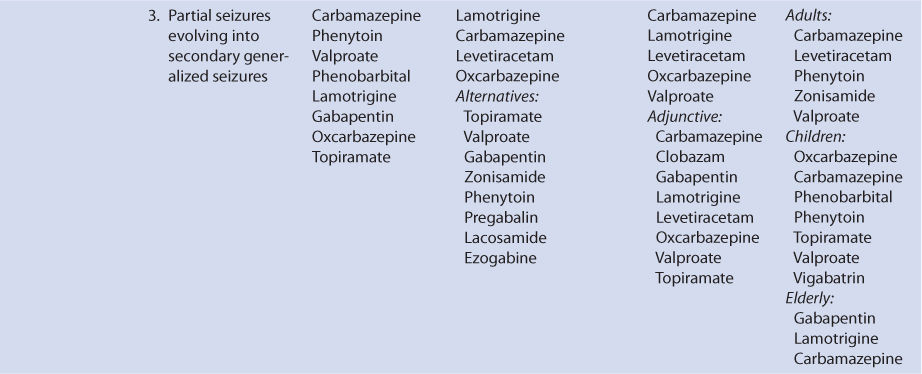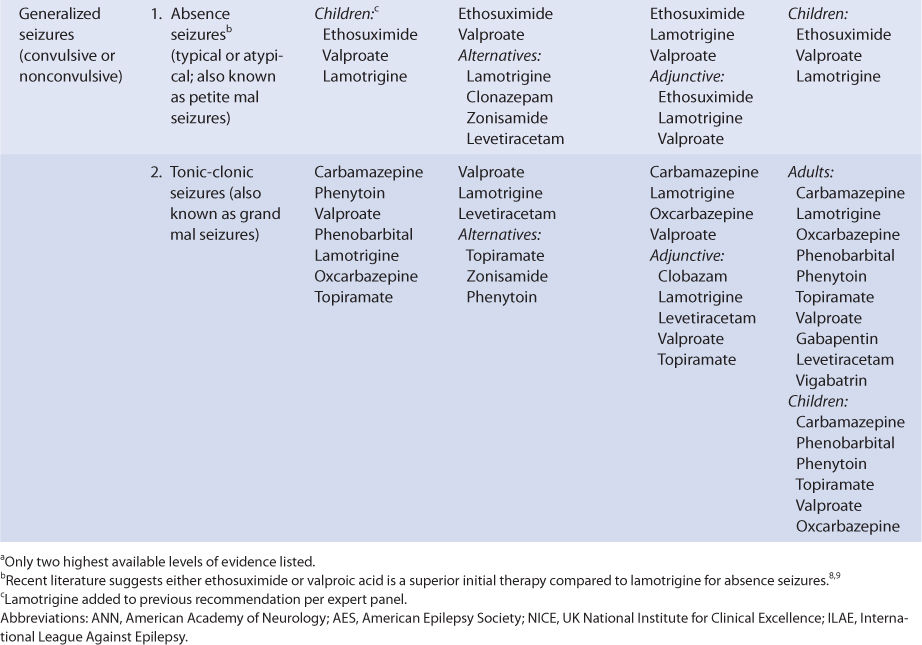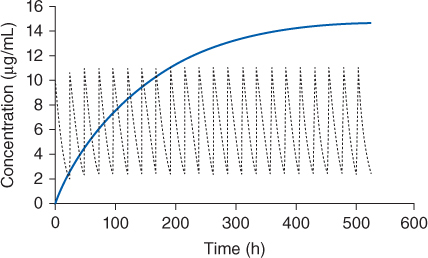
THERAPEUTIC AND TOXIC CONCENTRATIONS
The therapeutic range for phenobarbital and primidone are defined by most laboratories as 15-40 μg/mL and 5-12 μg/mL, respectively. When primidone is given, sufficient doses are usually administered to produce therapeutic concentrations of both phenobarbital and primidone. At present, concentrations of the other possible active metabolite of primidone, phenylethylmalonamide (PEMA) are not routinely measured. While animal experiments indicate that primidone has inherent antiseizure activity, some clinicians believe that phenobarbital is the predominate species responsible for the therapeutic effect of primidone in humans.7,10 Because phenobarbital and PEMA are produced via hepatic metabolism of primidone, it is very difficult to study the antiepileptic activity of primidone alone in patients.
The most common concentration-related adverse effects of phenobarbital involve the central nervous system: ataxia, headache, unsteadiness, sedation, confusion, and lethargy.6,11 Other concentration-related side effects are nausea, and in children, irritability and hyperactivity. At phenobarbital concentrations >60 μg/mL, stupor and coma have been reported. During long-term treatment with phenobarbital, changes in behavior, porphyria, decreased cognitive function, and osteomalacia can occur. For primidone, concentration-related side effects include nausea, vomiting, diplopia, dizziness, sedation, unsteadiness, and ataxia.6,11 Generally, slow dosage titration, administration of smaller doses and more frequent dosing of the drug produce relief from these side effects. Long-term treatment with primidone is associated with behavioral changes, decreased cognitive function, and disorders of the connective tissue. Obviously, some of the adverse effects noted during treatment with primidone may, in fact, be due to phenobarbital. Idiosyncratic side effects that are independent of concentration for both drugs include skin rashes and blood dyscrasias.
CLINICAL MONITORING PARAMETERS
The goal of therapy with anticonvulsants is to reduce seizure frequency and maximize quality of life with a minimum of adverse drug effects. While it is desirable to entirely abolish all seizure episodes, it may not be possible to accomplish this in many patients. Patients should be monitored for concentration-related side effects (diplopia, ataxia, dizziness, headache, unsteadiness, sedation, confusion, lethargy) as well as gastrointestinal upset (nausea, vomiting) when receiving these drugs. Serious, but rare, idiosyncratic side effects include connective tissue disorders, blood dyscrasias, and skin rashes.
Phenobarbital serum concentrations, or primidone plus phenobarbital serum concentrations for those patients receiving primidone therapy, should be measured in most patients. Because epilepsy is an episodic disease state, patients do not experience seizures on a continuous basis. Thus, during dosage titration it is difficult to tell if the patient is responding to drug therapy or simply is not experiencing any abnormal central nervous system discharges at that time. Serum concentrations are also valuable tools to avoid adverse drug effects. Patients are more likely to accept drug therapy if adverse reactions are held to the absolute minimum.
BASIC CLINICAL PHARMACOKINETIC PARAMETERS
Phenobarbital is eliminated primarily by hepatic metabolism (65%-70%) via CYP2C9 and CYP2C19 to inactive metabolites.12, 13 About 30%-35% of a phenobarbital dose is recovered as unchanged drug in the urine. Renal excretion of unchanged phenobarbital is pH dependent with alkaline urine increasing renal clearance. Phenobarbital is about 50% bound to plasma proteins. The absolute bioavailability of oral phenobarbital in humans approaches 100%.14 Phenobarbital is available in tablet (15, 16, 30, 60, 100 mg), solution (20 mg/5 mL), elixir (20 mg/5 mL), and injectable (65 mg/mL and 130 mg/mL for intravenous or intramuscular use) forms. The typical maintenance dose for phenobarbital is 2.5-5 mg/kg/d for neonates, 3-4.5 mg/kg/d for pediatric patients (<10 years old), and 1.5-2 mg/kg/d for older patients.6,11 For the acute treatment of status epilepticus, intravenous phenobarbital doses of 15-20 mg/kg are used.
Primidone is eliminated by hepatic metabolism (40%-60%) and renal excretion of unchanged drug (40%-60%).12 In adults, approximately 15%-20% of a primidone dose is converted by the liver into phenobarbital. Phenylethylmalonamide (PEMA) is another active metabolite of primidone.15,16 When starting treatment with primidone, PEMA concentrations are detectable after the first dose, but phenobarbital concentrations may not be measurable for 5-7 days (Figure 13-1). Primidone does not significantly bind to plasma proteins in humans. Because an intravenous form of the drug is not commercially available, the absolute bioavailability of primidone in humans is not known. Primidone is available as 50-mg and 250-mg tablets. Usual maintenance doses for primidone are 12-20 mg/kg/d for neonates, 12-23 mg/kg/d for pediatric patients (<15 years old), and 10-25 mg/kg/d for older patients.
FIGURE 13-1 Primidone and phenobarbital concentrations after administration of primidone. Primidone concentrations fluctuate over the dosage interval with half-lives of 8-15 hours, but phenobarbital concentrations accumulate slowly with an average half-life of 100 h in adults as primidone is converted to phenobarbital. Because of this, primidone concentrations achieve steady-state conditions long before phenobarbital concentrations reach steady-state. In order to measure steady-state serum concentrations of both drugs, one must wait at least 3-4 weeks after a primidone dosage change.
EFFECTS OF DISEASE STATES AND CONDITIONS ON PHARMACOKINETICS AND DOSING
Phenobarbital clearance rate (Cl) for older children (≥12 years old) and adults is 4 mL/h/kg, and for children is 8 mL/h/kg.11,14,17 Phenobarbital volume of distribution (V) equals 0.7 L/kg, and its half-life averages 120 hours in neonates (0-4 weeks old), 60 hours in children (≥2 months old), and 100 hours in adults. Although only limited studies in patients with hepatic disease are available, a 50% increase in half-life is seen in adults with liver cirrhosis or acute viral hepatitis.18 Based on this information, patients with liver cirrhosis or acute hepatitis may have reduced phenobarbital clearance because of destruction of liver parenchyma. This loss of functional hepatic cells reduces the amount of enzymes available to metabolize the drug and decreases clearance. An index of liver dysfunction can be gained by applying the Child-Pugh clinical classification system to the patient (Table 13-2).19 Child-Pugh scores are completely discussed in Chapter 3 (Drug Dosing in Special Populations: Renal and Hepatic Disease, Dialysis, Heart Failure, Obesity, and Drug Interactions), but will be briefly discussed here. The Child-Pugh score consists of five laboratory tests or clinical symptoms: serum albumin, total bilirubin, prothrombin time, ascites, and hepatic encephalopathy. Each of these areas is given a score of 1 (normal) to 3 (severely abnormal; see Table 13-2), and the scores for the five areas are summed. The Child-Pugh score for a patient with normal liver function is 5 while the score for a patient with grossly abnormal serum albumin, total bilirubin, and prothrombin time values in addition to severe ascites and hepatic encephalopathy is 15. A Child-Pugh score greater than 8 is grounds for a decrease of 25%-50% in the initial daily drug dose for phenobarbital. As in any patient with or without liver dysfunction, initial doses are meant as starting points for dosage titration based on patient response and avoidance of adverse effects. Phenobarbital serum concentrations and the presence of adverse drug effects should be monitored frequently in patients with liver cirrhosis.
Similarly, because phenobarbital is also eliminated by the kidney, patients with renal dysfunction (creatinine clearance <30 mL/min) receiving phenobarbital should be closely monitored. Phenobarbital is significantly removed (~30% of total body amount) by hemodialysis, and supplemental doses may need to be given after a dialysis session. Phenobarbital is significantly removed by hemoperfusion with a sieving coefficient equal to 0.8.20,21 Supplemental dosing during hemoperfusion should be guided by serum concentration monitoring. Phenobarbital enters the breast milk so nursing infants should be monitored for possible adverse drug reactions.22
The primidone clearance rate (Cl/F) for older patients (≥12 years old) taking primidone alone is 35 mL/h/kg.23 However, the primidone clearance rate increases to 50 mL/h/kg for older patients if they are receiving concurrent therapy with phenytoin or carbamazepine.23 For children primidone clearance averages 125 mL/h/kg.24 Primidone volume of distribution (V/F) equals 0.7 L/kg, and its half-life averages 8 hours in adults taking concurrent phenytoin or carbamazepine or children (<12 years old), and 15 hours in adults taking primidone alone.11,23,24 Although no studies in patients with hepatic or renal disease are available, because almost equal amounts of primidone are eliminated by the liver and kidney, patients with renal or hepatic dysfunction receiving primidone should be closely monitored. A Child-Pugh score greater than 8 or creatinine clearance <30 mL/min are grounds for a decrease of 25%-50% in the initial daily drug dose for primidone. As in any patient with or without liver dysfunction, initial doses are meant as starting points for dosage titration based on patient response and avoidance of adverse effects. Primidone and phenobarbital serum concentrations as well as the presence of adverse drug effects should be monitored frequently in patients with liver or kidney disease taking primidone. Primidone is significantly removed (~30% of total body amount) by hemodialysis, and supplemental doses may need to be given after a dialysis session.
DRUG INTERACTIONS
Phenobarbital is a potent inducer of hepatic drug metabolism for the CYP1A2, CYP2C9, CYP2C19, and CYP3A4 enzyme systems.13,25 Because phenobarbital is also a metabolite produced during primidone therapy, primidone has similar drug interaction potential.13,25 Because phenobarbital is such a broad-based hepatic enzyme inducer, patients should be monitored closely for drug interactions whenever either of these agents are added to their therapeutic regimen. A brief list of the compounds whose metabolism and clearance are increased by concurrent phenobarbital treatment includes carbamazepine, lamotrigine, valproic acid, cyclosporin, nifedipine, diltiazem, verapamil, oral contraceptives, tricyclic antidepressants, quinidine, theophylline, and warfarin. Other anticonvulsants that decrease the metabolism and clearance of phenobarbital are felbamate and valproic acid. Phenytoin may also exhibit a co-interaction with phenobarbital where both agents change the metabolism and clearance of each other. The net result of this drug interaction is quite variable and can result in an increase, decrease, or no change in the steady-state concentration of both drugs. Primidone metabolism and clearance are increased by carbamazepine and phenytoin treatment while valproic acid therapy decreases primidone metabolism and clearance.
INITIAL DOSAGE DETERMINATION METHODS
Several methods to initiate phenobarbital or primidone therapy are available. The Pharmacokinetic Dosing method is the most flexible of the techniques. It allows individualized target serum concentrations to be chosen for a patient, and each pharmacokinetic parameter can be customized to reflect specific disease states and conditions present in the patient. Literature-based Recommended Dosing is a very commonly used method to prescribe initial doses of phenobarbital or primidone. Doses are based on those that commonly produce steady-state concentrations in the lower end of the therapeutic range, although there is a wide variation in the actual concentrations for a specific patient.
Pharmacokinetic Dosing Method
The goal of initial dosing of phenobarbital or primidone is to compute the best dose possible for the patient given their set of disease states and conditions that influence pharmacokinetics of the drugs and the epileptic disorder being treated. In order to do this, pharmacokinetic parameters for the patient will be estimated using average parameters measured in other patients with similar disease state and condition profiles.
Clearance Estimate
Phenobarbital is predominately metabolized by liver while primidone is about 50% hepatically eliminated. Unfortunately, there is no good way to estimate the elimination characteristics of liver-metabolized drugs using an endogenous marker of liver function in the same manner that serum creatinine and estimated creatinine clearance are used to estimate the elimination of agents that are renally eliminated. Because of this, a patient is categorized according to the disease states and conditions that are known to change drug clearance, and the clearance previously measured in these studies is used as an estimate of the current patient’s clearance. For example, for a 70-kg adult patient, phenobarbital clearance would be assumed to equal 4 mL/h/kg: 70 kg • 4 mL/h/kg = 280 mL/h or 0.28 L/h. To produce the most conservative phenobarbital or primidone doses in patients with multiple concurrent disease states or conditions that affect their respective pharmacokinetics, the disease state or condition with the smallest clearance should be used to compute doses. This approach will avoid accidental overdosage has much as currently possible.
Volume of Distribution Estimate
The volume of distribution of both drugs is assumed to equal 0.7 L/kg for adults and children. Thus, for a 70-kg adult patient, the estimated volume of distribution would be 49 L: V = 0.7 L/kg • 70 kg = 49 L.
Half-Life and Elimination Rate Constant Estimate
Once the correct clearance and volume of distribution estimates are identified for the patient, they can be converted into the half-life (t1/2) and elimination rate constant (k) estimates using the following equations: t1/2 = (0.693 • V)/Cl, k = 0.693/t1/2 = Cl/V.
Selection of Appropriate Pharmacokinetic Model and Equations
Primidone and phenobarbital follow a one-compartment pharmacokinetic model. When oral therapy for either drug or intramuscular treatment with phenobarbital is required, both anticonvulsants have good bioavailability (assume F = 1), and once daily dosing for phenobarbital or multiple daily dosing for primidone provides a relatively smooth serum concentration-time curve that emulates an intravenous infusion. Because of this, a very simple pharmacokinetic equation that computes the average phenobarbital or primidone steady-state serum concentration (Css in μg/mL = mg/L) is widely used and allows maintenance dosage calculation: Css = [F(D/τ)]/Cl or D = (Css • Cl • τ)/F, where F is the bioavailability fraction for the oral dosage form (F = 1 for both drugs), D is the dose of the anticonvulsant in mg, Cl is anticonvulsant clearance in L/h, and τ is the dosage interval in hours.
When intravenous therapy with phenobarbital is required, a similar pharmacokinetic equation is widely used: Css = (D/τ)/Cl or D = Css • Cl • τ, where D is the dose of phenobarbital in mg, and τ is the dosage interval in hours. Cl is phenobarbital clearance in L/h. The equation used to calculate an intravenous loading dose for phenobarbital (LD in mg) is based on a simple one-compartment model: LD = Css • V, where Css is the desired phenobarbital steady-state concentration in μg/mL, which is equivalent to mg/L, and V is the phenobarbital volume of distribution. Intravenous phenobarbital doses should be administered no faster than 100 mg/minute.
Literature-Based Recommended Dosing
Because of the large amount of variability in phenobarbital and primidone pharmacokinetics, even when concurrent disease states and conditions are identified, most clinicians believe that the use of standard drug doses for various situations are warranted. The original computation of these doses were based on the Pharmacokinetic Dosing methods, and subsequently modified based on clinical experience. In general, the expected steady-state serum concentrations used to compute these doses was in the lower end of the therapeutic range for each drug (Table 13-3). Phenobarbital is usually administered once or twice daily while primidone is given 2-4 times daily. To avoid side effects, primidone doses are started at 25%-50% of the ultimate desired maintenance dose with dosage increases made every 1-2 weeks depending on response and adverse effects. If the patient has significant hepatic dysfunction (Child-Pugh score ≥8) or renal disease (creatinine clearance <30 mL/min), maintenance doses prescribed using this method should be decreased by 25%-50% depending on how aggressive therapy is required to be for the individual.
To illustrate the similarities and differences between this method of dosage calculation and the Pharmacokinetic Dosing method, the same examples used in the previous section will be used.
USE OF PHENOBARBITAL AND PRIMIDONE SERUM CONCENTRATIONS TO ALTER DOSES
Stay updated, free articles. Join our Telegram channel

Full access? Get Clinical Tree












